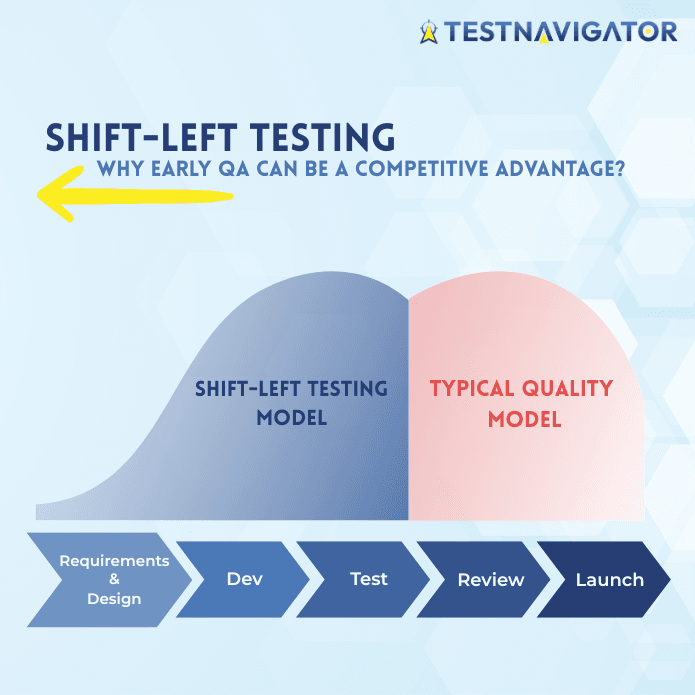
One of the constant challenges in software development is how to deliver higher quality, faster time-to-market, and fewer defects. The answer increasingly lies in shift-left testing – moving testing activities earlier in the development process. A key part of this approach is test case prioritization, ensuring that the most critical tests are executed first to maximize defect detection and provide rapid feedback. By adopting shift-left testing, teams can identify issues sooner, reduce rework, and achieve greater efficiency across the software lifecycle. But what exactly does this mean, and why can it be a true competitive advantage?
What is shift-left testing?
The term "shift-left" refers to bringing testing activities forward, from the end of the development cycle into its earliest phases. If we imagine the development process as a timeline moving from left to right, then shift-left simply means moving testing "to the left."
This doesn’t just mean involving QA engineers sooner. It also requires closer collaboration between developers, testers, and business stakeholders, ensuring that testing happens continuously throughout the entire lifecycle.
Why is late testing a problem?
Anyone who has ever taken part in a software project knows: bugs always appear at the worst possible time. If bugs are only discovered at the end of the project, they become more expensive to fix, deadlines may be at risk, new bugs may appear due to the fixes, and as a result the team ends up working overtime and rushing.
In other words: it’s not the amount of testing that matters most, but the timing of the testing.
How does the shift-left approach work?
The foundation of shift-left testing is continuous and layered testing. Some practical examples include:
- Unit testing: verifying individual modules in isolation, often as part of Test-Driven Development (TDD).
- Integration testing: checking how different components work together.
- API testing: especially critical in microservices architectures, ensuring reliable communication between services.
- UI testing: validating the application’s functionality through the user interface. Automated test management tools such as TestNavigator can greatly support this process.
But shift-left is not only about automating testing processes: testers are already involved in the requirements phase, helping to create better architecture and prevent defects.
Connection to agile and DevOps
In modern software development, shift-left is closely tied to CI/CD pipelines. Automated tests run with every code commit, and feedback reaches developers almost instantly. This enables faster reaction times and shorter release cycles.
Here, TestNavigator can give testing teams a real competitive advantage. It’s an AI-powered testing support tool that integrates seamlessly into CI/CD processes and intelligently prioritizes test cases – saving valuable time and effort.
Shift-left security testing is also becoming increasingly important: security checks such as code analysis and static testing are introduced early, so vulnerabilities can be addressed during development instead of after release.
The benefits of shift-left testing
- Cost savings: fixing a defect before release is much cheaper than fixing it in production.
- Faster time-to-market: shorter bug-fixing cycles, fewer delays.
- Better developer experience: fewer last-minute firefighting sessions, smoother release processes.
- More stable systems: early testability results in more transparent, maintainable, and robust software.
- Higher quality and user experience: fewer critical issues reach the end users.
These benefits of shift-left testing become even more tangible with the right tools. TestNavigator was built to support early, continuous, and effective testing by combining coverage measurement, change detection, and test case prioritization. With its intelligent prioritization engine, teams can focus first on the most critical tests, while comprehensive coverage analysis and change tracking ensure that no defect slips through unnoticed. Add to this the built-in test case management, source code visualization, and seamless integrations, and TestNavigator provides a complete platform to accelerate delivery, reduce costs, and raise software quality from the very start of development.
Shift-left and shift-right: complementary approaches
While shift-left focuses on early testing, shift-right testing – validation in production environments – is equally important. The two approaches complement each other: shift-left reduces the number of defects, while shift-right enables teams to quickly detect and resolve real-world issues. Together, they create a continuous quality loop that strengthens the entire software lifecycle. A dedicated platform like TestNavigator also makes it easier to connect these practices into one workflow by centralizing test case management, offering transparent reporting, and integrating seamlessly with CI/CD pipelines.
Early, continuous and collaborative
Shift-left testing is not just another buzzword, but a mindset that emphasizes early, continuous, and collaborative testing. Teams that adopt this approach can deliver their software faster, cheaper, and at higher quality.
For those seeking a competitive edge in the software market, the message is clear: it’s time to start shifting testing to the left.